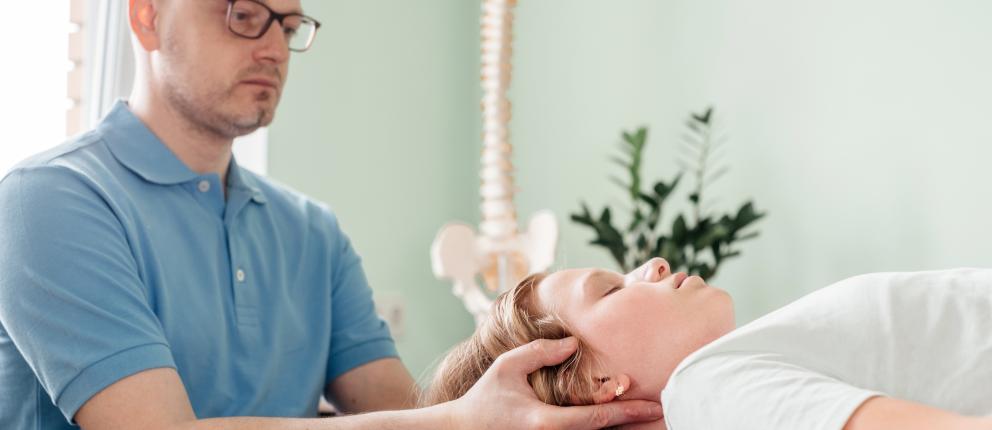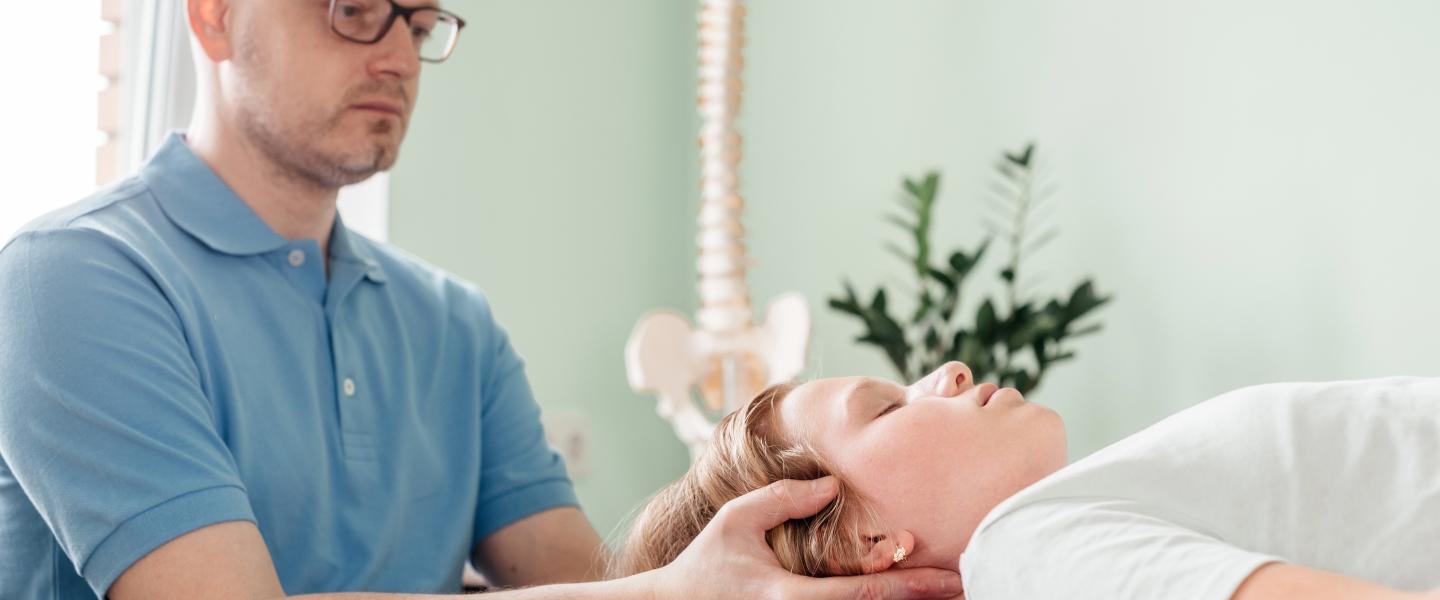Program Overview
Craniosacral therapy addresses the body, the head and the nervous system from the point of view developed by early osteopaths. With a certificate in craniosacral therapy, you’ll be able to treat musculoskeletal issues to gently release restrictions in movement to restore normal motion to the bones, joints and soft tissue. It is also an effective modality for treating chronic pain, such as migraine headaches and fibromyalgia, as well as addressing the emotional response to trauma which is held in the body.
Approximately one year
63 total CEUs - Certificate of Craniosacral Therapy granted upon completion of full program requirements.
See registration page for cost
Course Details
(21 CEUs) The fascial system and its critical role in health and well-being will be discussed, from the specific to the whole body (including the membranes of the head). You will learn to recognize and assess the craniosacral rhythm at various points in the body, and to use it as an assessment tool. Learn to perform the still-point technique and dural tube glide and explore the role of these techniques in normalizing tensions throughout the body. Additionally, we will cover the importance of the various membranes within the craniosacral system, including ways to assess restriction within the membrane system and recognize its implications on general well-being and health. The seminar includes a combination of lectures, demonstrations, and hands-on practice. There are 23 in-class hours plus 5-10 hours of pre-reading assignments.
Health care practitioners who complete Level 1 may immediately incorporate these techniques in their practice, as well as go on to take Levels 2 and 3.
Course Objectives
-
Describe the function of the fascia.
-
Treat fascial restrictions using direction of energy technique.
-
Assess and treat restrictions in the muscles, joints and extremities.
-
Assess and treat restrictions for the body diaphragms.
-
Describe the basic elements of the craniosacral (CS) system, including the meninges and cranial membranes.
-
Assess the CS rhythm.
-
Induce a still point in the CVS rhythm.
-
Describe the structure and function of the tentorium and falx.
-
Assess and release the tentorum using the sphenoid and temporal bones.
-
Assess and release the falx using the frontal and parietal bones.
-
Describe the structure and function of the sacral base.
-
Release the joints of the sacral base (sacroiliac and lumbo-sacral).
-
Perform a dural tube glide.
-
Assess when it is appropriate to make referrals to other health care or mental health professionals.
Textbook Requirements
-
Rhythm and Touch: The Fundamentals of Craniosacral Therapy (Links to an external site.), by Anthony Arnold.
-
An Integrative Approach to Craniosacral Therapy - Fascial Connection (Links to an external site.), by Faith Christensen and Masahiro Takakura.
-
Pocket Anatomy and Physiology (Links to an external site.), by Shirley A. Jones (for CST Levels 1 & 2)
It is recommended that you register at least two weeks prior to class start in order to complete the reading assignments.
(21 CEUs) The focus of this Level 2 seminar is on assessment and treatment of lesions in the cranium and facial bones. A full set of skills to address 16 bones in the cranium will be presented. The techniques build upon and integrate with Level 1 techniques for working with the cranial membranes, as well as the connections within the entire body.
The seminar includes a combination of lecture, demonstration and hands-on practice. Healthcare professionals who complete Levels 1 and 2 will have a comprehensive set of craniosacral skills in the biomechanical-structural approach to address restrictions in the body and head. In addition, this seminar provides the necessary skills for massage therapists to apply for Intraoral Endorsement in the State of Washington. Further integration of these skills with a holistic approach to the mind, body, and spirit is presented in Level 3. The seminar includes a combination of lecture, demonstration and hands-on practice.
Additional supervised practice sessions will be available for those who wish to fine-tune their craniosacral skills ($20 per session payable to the supervising practitioner).
Course Objectives
-
Conduct a basic cranial bone assessment of the head, using movements of the cranial and facial bones to determine restriction patterns in the head.
-
Explain the differences between open, fixed and compressed sphenoid lesion patterns.
-
Use techniques to correct sphenoid lesion patterns by releasing restrictions associated with the sphenoid lesion pattern from within the body, the dural system or the vault.
-
Conduct a basic assessment and treatment of the ethmoid, vomer, maxilla, zygoma, palatine and mandible bones, with relation to the bones around it.
-
Conduct a basic assessment and treatment of dysfunction of the TMJ.
-
Conduct a basic assessment and treatment of the tongue and the floor of the mouth.
Prerequisites
Participants must be licensed health care practitioners who are licensed to touch. We can also accept students who are training in those fields.
Participants must have completed Craniosacral Therapy Level 1 prior to this course start date.
(21 CEUs) This seminar explores current theory on trauma and its resolution. It provides practitioners with tools that allow their craniosacral practice to address their clients more holistically. Skills taught include creating a safe environment for a client to allow for an emotional release, assessment techniques, listening skills, appropriate dialogue, and use of unwinding of the body. Breathing techniques will also be used as adjuncts to releasing trauma. Additionally, we will address how the practitioner can triage an emotionally loaded situation and determine if outside referral is necessary.
Level 3 serves as a wrap-up of the three-class series, pulling together all the elements that a practitioner has learned to create a comprehensive set of skills to add to their practice. The seminar includes a combination of lecture, demonstration and hands-on practice.
Additional supervised practice sessions will be available for those who wish to fine-tune their craniosacral skills ($20 per session payable to the supervising practitioner).
Course Objectives
-
Describe the “normal” reaction to trauma and how this process is often thwarted.
-
Describe the life events that can become held-emotional-trauma.
-
Describe how a thwarted response to trauma causes the emotional aspects of the trauma to become archived in the tissues of the body, held in such a way as to create restrictions.
-
Assess for and recognize held-emotional-trauma in the course of the regular assessment and treatment of the client with craniosacral.
-
Assess the appropriateness of engaging the client emotionally in a particular setting.
-
Assess the appropriateness of using craniosacral as the modality for the release of held-emotional-trauma.
-
List other options available for resolution of trauma and make appropriate referrals when necessary.
-
Demonstrate techniques for creating a safe and caring environment for the client.
-
Demonstrate appropriate listening and dialoguing techniques for facilitating the discovery and release of held-emotional-trauma.
-
Demonstrate use of craniosacral techniques such as listening, following, releasing and unwinding as part of the process of releasing held-emotional-trauma.
-
Demonstrate the use of the stillpoint technique as a possible way to facilitate the client’s insight into the meaning of the held-emotional-trauma, as well as a way for the client to self-manage anxiety as they process memories.
-
Demonstrate the use of stillpoint breathing as a way to help the client to breathe through the release, as well as a way for the client to self-manage emotional trauma which surfaces when they are on their own.
Prerequisites
Participants must be licensed health care practitioners who are licensed to touch. We can also accept students who are training in those fields.
Participants must have completed Craniosacral Therapy Level 1 prior to this course start date.




